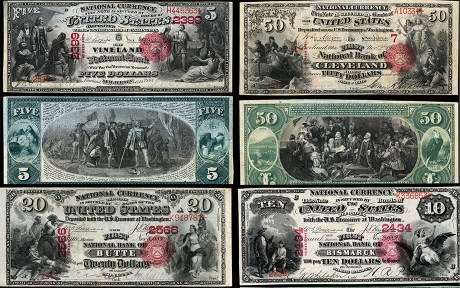
Digital currencies have grown rapidly in recent years. In July 2025, Congress passed the “Guiding and Establishing National Innovation for U.S. Stablecoins Act” (GENIUS) Act, establishing the first comprehensive federal framework governing the issuance of stablecoins. In this post, we place stablecoins in a historical perspective by comparing them to national bank notes, a form of privately issued money that circulated in the United States from 1863 through 1935.
What Are Stablecoins?
Stablecoins are digital currencies designed to maintain a stable nominal value by being pegged to a benchmark such as the U.S. dollar. Stablecoins aim to combine decentralized payment systems’ technological advantages—such as digital methods of recording transactions (i.e., digital ledgers/blockchains) and of representing traditional assets (e.g., tokenization)—with the convenience of traditional forms of money.
The GENIUS Act gives fiat-backed stablecoins a clear legal foundation in the United States. Under the Act, permitted payment stablecoin issuers (PPSIs), such as federally regulated banks, approved nonbanks, or qualifying state-chartered entities, are authorized to issue stablecoins. Stablecoins under the Act must be fully backed one-to-one by safe, liquid assets such as U.S. dollars, short-term Treasury securities, uninsured deposits at commercial banks, or cash equivalents. Issuers may not pay interest or yields on stablecoin balances, and holders enjoy priority claims in bankruptcy. To promote transparency, issuers must provide monthly public disclosures of their reserves.
National Bank Notes: A Historical Parallel
Stablecoins may feel novel but, conceptually, they echo an earlier era of U.S. financial history. From 1863 to 1935, “national bank notes” circulated widely as a form of private money that was backed by public debt. Authorized by the National Banking Acts of 1863 and 1864, these notes were issued by national banks, which were commercial banks chartered under federal law.
How did note issuance by national banks work? A bank could apply for a national bank charter by the Office of the Comptroller of the Currency if it fulfilled a set of requirements such as having a minimum amount of capital. Once the bank was granted a national bank charter, it could use its capital to purchase government bonds. To print notes, the bank then had to deposit with the Treasury U.S. government bonds that were eligible for note issuance. National bank notes were redeemable in lawful money such as specie (coin) or greenbacks (paper money issued by the Treasury directly). Typically, a bank could issue notes valued at up to 90 percent of the par value of the government bonds it deposited. This structure ensured that the notes were overcollateralized, with government bonds available to protect note holders in case the issuing bank defaulted. Indeed, for the more than 2,000 national bank failures that took place from 1863 through 1935, no losses were ever incurred by holders of national bank notes.
The original motive of the National Banking Acts was twofold. First, the issuance of national bank notes was intended to create a uniform currency. Before the National Banking Era (1863-1913), during the so-called Free Banking Era (1837-1863), banks were typically legally required to back any note issuance with bonds of the state governments. Because states tended to default frequently, state bonds were a risky investment. Such risk often led to concerns about the value of the bank notes, and thus the same bank note often had a different market value in different parts of the country at the same point in time, reducing its usefulness as a form of money for transaction purposes. Providing a currency for circulation through the newly formed national banking system was an attempt to create a uniform currency in which bank notes had the same value in all parts of the country.
Second, directly connecting the issuance of national bank notes to federal government bonds was a means to increase demand for the bonds. The federal government saw a large rise in its expenses during the Civil War, and, to finance those expenses, it desired to issue government bonds. Thus, it was expedient to create a currency based on its own debt.
National banks, however, did more than just issue bank notes and invest in government bonds. They essentially operated two lines of business within the same entity. First, they operated a note-issuing business that allowed them to earn interest on government bonds while paying no interest to note holders. National banks therefore captured most of the “seigniorage” (government revenue received through creating money) during the National Banking Era. Second, national banks operated regular commercial banking businesses in which they financed loans and securities through deposits and equity, just like commercial banks do nowadays.
What Can History Teach Us About the Potential Success of Stablecoins?
These historical details show that national bank notes and stablecoins have many commonalities. Similar to national bank notes, stablecoins under the GENIUS Act are privately issued but can be partially or fully backed by government securities. Moreover, they are issued by many private entities that are granted a charter to earn seigniorage from holding government bonds. Like national banks, issuers of stablecoins can also engage in other lines of business. Finally, stablecoins, like national bank notes, promise to be redeemable at par and the one-to-one convertibility with government money is supposed to be maintained even when the issuer fails and defaults on other liabilities that are not stablecoins.
National bank notes were initially successful for two main reasons. First, given that they were traded at the same price as greenbacks and specie, they were a more useful form of money than other circulating notes. Second, bank notes faced little competition from other forms of money, such as bank deposits. Before the rise of deposit insurance, deposits were often risky investments and, historically, not a widely accepted form of payment.
However, as the interbank system in the U.S. developed, the use of deposits for payments became increasingly common. While national bank notes represented around 20 percent of total bank assets by the end of 1880, that share declined thereafter, as shown in the chart below. The decline in bank notes was mirrored by the increase in deposits. This pattern is in line with a decline in the demand for bank notes and the rise of bank deposits as an alternative source of money.
National Bank Notes and Deposits During the National Banking Era
Share of total bank assets (percent)
Notes: This chart shows the total of national bank notes and deposits as a share of total national bank assets from 1863 through 1935.
Bank deposits had an advantage over national bank notes in that they were able to earn interest. And while deposits remained risky investments, they became increasingly attractive as payment systems improved. Eventually, most households and firms that desired to hold money for transaction purposes held deposits rather than national bank notes, and they either used checks or wired money from bank to bank to make payments, rather than carrying notes.
This dynamic between national bank notes and bank deposits is a cautionary tale for the potential rise of stablecoins. Currently, most retail deposits pay little interest. Moreover, banks charge considerable fees for large instant payments such as wire fees. However, as stablecoins become more commonly used, the traditional centralized payment system may move to become more attractive in response. To avoid losing valuable deposits, banks may start to offer better terms on deposits or offer both higher interest and better payment services, just as they did during the National Banking Era. Alternatively, bank deposits may become “tokenized” themselves.
Thus, at least for domestic payments, the footprint of stablecoins may be limited given that many potential retail depositors may stick with bank deposits. For international payments, because the scope for improvements in the efficiency of the international payment system is itself more limited, demand for stablecoins may be highest from international investors that either require seamless cross-border payments, otherwise have no access to reliable forms of money, or prefer decentralized payment systems for other reasons.
Wrapping Up
Stablecoins under the GENIUS Act share important features with national bank notes: both are forms of private money backed by federal government debt. The historical experience of national bank notes illustrates that stablecoins may have a large potential to increase the demand for U.S. government debt. However, at the same time, the demise of national bank notes and the rise of bank deposits also suggest that other forms of money may become more attractive as a consequence of the new competition. While this would arguably be a desirable effect of the GENIUS Act, it may also induce a natural upper limit for the growth of the market for stablecoins themselves.

Stephan Luck is a financial research advisor in the Federal Reserve Bank of New York’s Research and Statistics Group.
How to cite this post:
Stephan Luck, “A Historical Perspective on Stablecoins,” Federal Reserve Bank of New York Liberty Street Economics, October 1, 2025, https://doi.org/10.59576/lse.20251001
BibTeX: View |
Disclaimer
The views expressed in this post are those of the author(s) and do not necessarily reflect the position of the Federal Reserve Bank of New York or the Federal Reserve System. Any errors or omissions are the responsibility of the author(s).













 RSS Feed
RSS Feed Follow Liberty Street Economics
Follow Liberty Street Economics
Thanks for this article. Excellent read.